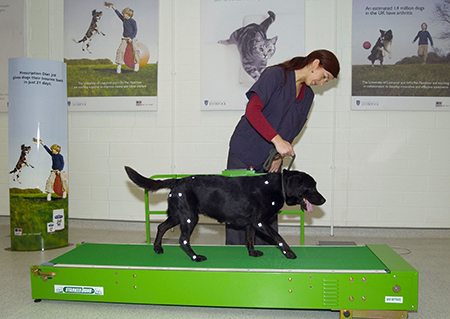Pressure sensitive walkways are a reliable way of measuring limb function, but are only available at a small number of UK research centres
Veterinary scientists at the University of Liverpool have developed a new tool to support clinicians in treatment programmes for osteoarthritis in dogs.
Unlike most other diseases, which can be monitored by blood tests, there is no test for how uncomfortable a dog is when walking or how good their quality of life is as arthritis progresses.
Subjective
At Liverpool, veterinary scientists can measure ground reaction forces, such as peak vertical force, using force platforms or pressure-sensitive walkways, as a reliable way of measuring limb function, but it is currently available at very few research centres in the UK.
The University has a dedicated gait analysis suite in daily use: it includes a highly sensitive force platform, high speed 3D motion capture, and slow-motion video
Dr Ben Walton, from the University’s School of Veterinary Science, said: “In first opinion and referral practices canine mobility is assessed in a subjective fashion, either by a vet or owner. Assessment can differ between vets, and if more than one limb is affected it becomes even more difficult.
Dr Walton continued: “The most reliable data on this disease is often gathered from informally asking owners for their observations of their pet’s behaviour. The difficulty until now has been knowing how to reliably record this valuable information so that it can recalled the next time the patient visits.”
Osteoarthritis results in loss of cartilage and the formation of spurs of bone around the joint, and is associated with pain, stiffness and reduced activity levels
The team at Liverpool has devised a new tool, in questionnaire form, that attaches score rates to quantify the level of disease against key questions addressed to the dog’s owner. The information is recorded digitally so that it can be referred to throughout a patient’s treatment programme.
Grade activity and exercise levels
Owners are asked to grade their dog’s activity and exercise levels, stiffness and lameness, and any changes that occur in different weather conditions.
Dr Walton added: “Pain is a subjective experience, so it is not unreasonable to measure it on a subjective scale. Owners are the best judge of their pet’s behaviour and how they might be feeling.
“This record of behaviour history, together with clinical assessment, could provide a more detailed understanding of how the disease is progressing, and importantly how healthy and comfortable the dog is.”
The research is published in PLOS ONE
For more information on the Liverpool Osteoarthritis in Dogs (LOAD) tool please contact Professor John Innes on j.f.innes@liv.ac.uk or Dr Ben Walton on Ben.Walton@liv.ac.uk
